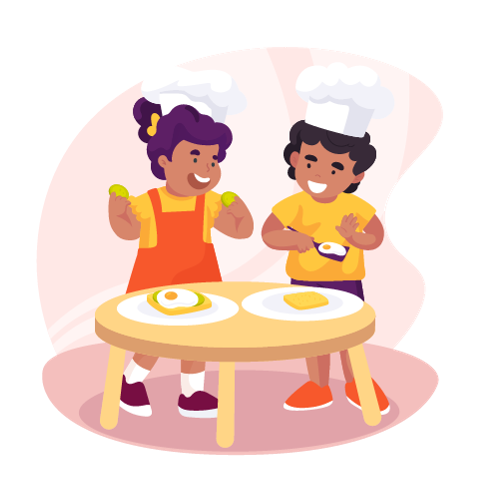As a parent, the struggle to feed a picky eater can be frustrating and exhausting. You've probably tried every trick in the book, from bribery to negotiation, but nothing seems to work. However, there might be a delicious solution hiding in plain sight: baking and cooking with your child.
In this blog post, we'll explore how getting your child involved in the kitchen can transform their picky eating habits.
Understanding picky eating
Picky eating in children is a common phenomenon, often characterised by a limited range of foods they are willing to eat. While some picky eating is typical in young children, it can become a concern when it severely limits their diet and affects their growth and development. Research suggests that genetics, sensory sensitivity, and environmental factors all play a role in picky eating behaviors.
The power of involvement
One effective strategy for expanding a picky eater's palate is to involve them in the meal preparation process. When children participate in cooking and baking activities, they develop a sense of ownership and curiosity about the food they are making. Research published in the journal "Appetite" indicates that involving children in meal preparation can positively influence their food preferences and increase their willingness to try new foods.
Exploring new flavours and textures
Baking and cooking expose children to a variety of flavours, textures, and aromas, helping them become more familiar with different foods. By engaging their senses, children can overcome their aversions to certain foods and become more receptive to trying them. Studies have shown that repeated exposure to unfamiliar foods in a positive and interactive setting can lead to greater acceptance and enjoyment of those foods over time.
Building confidence and independence
When children take an active role in the kitchen, they gain confidence in their abilities and develop important life skills. Whether they're measuring ingredients, mixing batter, or shaping dough, each task helps build their self-esteem and sense of accomplishment. Research published in the "Journal of Nutrition Education and Behavior" suggests that involving children in meal preparation can also improve their overall dietary quality and encourage healthier eating habits into adulthood.
...children who participated in cooking classes were more willing to try new foods and had a greater appreciation for fruits and vegetables.
Creating positive associations
The kitchen can be a place of fun, creativity, and bonding for families. When children associate cooking and baking with enjoyable experiences, they are more likely to have positive associations with the foods they help prepare. This positive reinforcement can gradually shift their attitudes towards previously disliked foods. A study in the "Journal of the Academy of Nutrition and Dietetics" found that children who participated in cooking classes were more willing to try new foods and had a greater appreciation for fruits and vegetables.
Enjoying food with peers
Research suggests that children might be more open to trying foods they typically dislike when they're with peers who show enthusiasm for those foods. This concept, known as social facilitation or peer influence on eating behavior, can be a game-changer for parents dealing with picky eaters. A study featured in "Appetite" revealed that preschoolers were more likely to embrace new fruits and vegetables when they saw their friends enjoying them, hinting at the power of peer influence in shaping food preferences. Similarly, research published in the "Journal of Nutrition Education and Behavior" showed that elementary school children were more inclined to eat vegetables after witnessing their peers doing the same. These findings underscore the significance of creating positive mealtime environments where children can be encouraged by their peers to explore new foods, offering hope for parents seeking to broaden their picky eater's palate.
Tips to transform picky eaters
Now that you understand the benefits of cooking and baking for picky eaters, here are some tips to help you get started:
- Choose simple recipes that your child can easily participate in, such as homemade pizza, muffins, or fruit salad. Check out our post on fun activities with kids in the kitchen for more ideas.
- Let your child pick out ingredients at the grocery store or farmer's market to spark their interest in the cooking process.
- Create a positive and supportive atmosphere in the kitchen, praising your child's efforts and encouraging them to explore new foods.
- Involve your child in group baking and cooking classes for kids. Seeing other kids enjoying making food and eating them can increase their interest in the kitchen and encourage them to broaden their palate.
- Be patient and persistent. It may take time for your child to become comfortable with trying new foods, so keep offering them without pressure or coercion.
Cooking and baking with your picky eater can be a game-changer in expanding their palate and fostering a healthier relationship with food. By involving them in the kitchen, you not only empower them with valuable life skills but also create lasting memories together. So roll up your sleeves, preheat the oven, and watch as your little chef transforms into a more adventurous eater one delicious dish at a time.
References
Birch LL, et al. (2007). Children's food preferences: development, mechanisms, and interventions. Appetite, 52(1), 2-14.
Fulkerson JA, et al. (2015). Positive effects of family dinner are undone by television viewing. Journal of the Academy of Nutrition and Dietetics, 115(4), 559-566.
Larson N, et al. (2017). Eating breakfast and dinner together as a family: associations with sociodemographic characteristics and implications for diet quality and weight status. Journal of the Academy of Nutrition and Dietetics, 117(1), 80-89.
Van der Horst K, et al. (2014). A systematic review of environmental correlates of obesity-related dietary behaviors in youth. Health Education Research, 29(6), 822-835.
Wardle, J., Herrera, M. L., Cooke, L., & Gibson, E. L. (2003). Modifying children's food preferences: the effects of exposure and reward on acceptance of an unfamiliar vegetable. Appetite, 40(2), 155-162.
Birch, L. L., Birch, D., Marlin, D. W., & Kramer, L. (1982). Effects of instrumental consumption on children's food preference. Appetite, 3(2), 125-134.



